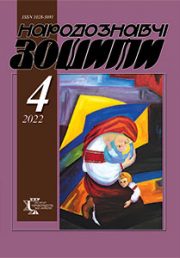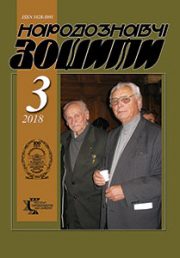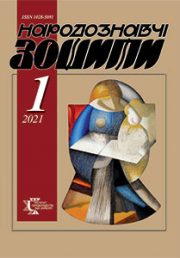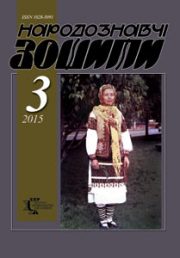The Ethnology Notebooks. 2019, № 5 (149), 1274—1285
UDK 77.04:392(477.74)
DOI https://doi.org/10.15407/nz2019.05.1274
DMITRYUK Viktoriia
ORCID ID: https://orcid.org/0000-0002-3104-6787
Graduate of the Department of Archeology and Ethnology
Odesa I. I. Mechnikov National University
custodian of funds of the 2nd qual. categories of the Odesa department
National Research and Restoration Center of Ukraine
Voznesensky lane, 7, 65 007, Odessa, Ukraine
e-mail: vik.vik.od.2018@gmail.com
Abstract. With the beginning of the twentieth century, photographing became an important part of the procedure for conducting many ritual actions, and from the second half of the twentieth century it was necessary. During this time, a certain photographic ritual was formed, amateur practices became common, which led to the emergence of a new type of sources, conventionally called photo folklore. Photos reflecting the passage or the fact of the ritual itself have received the status of official public documentary, visual evidence and can be considered unique sources for studying the historical process as a whole and its various aspects. At the present stage, questions about the features of their creation are being updated, to identify study and preserve such materials. In the proposed intelligence, the author sets himself the goal of finding out the features of the photographic practices of the transition rites in the comparative perspectives of various ethnic, territorial, social and other groups of the Odesa region. The emphasis was placed on trends in the transition of private practices to public ones, which led to the obligatory photofixation of certain transitional rites in the ХХІ century. The object of the study is photographs of family, photo albums of residents of the Odesa region, and the subject is the developed and unmanifest participants and customers of photographic practices related to the rites of passage. The methodological basis of the study was the general scientific principles of historicism, systemicity, scientific objectivity, which made it possible to carry out the necessary scientific analysis of the topic as a whole, as well as its individual aspects. The source study base was formed during their own research trips, as well as as part of complex historical and ethnographic expeditions of the Odesa I. I. Mechnikov National University during 2012–2019, that fixation was carried out using photographing and oral interviewing of respondents. Therefore, the basis of the work is the author’s field materials and materials of the Archive of the laboratory of the Department of Archeology and Ethnology of the Odesa I. I. Mechnikov National University.
Keywords: photo folklore, Odesa region, rites of passage, family photography, practice photography.
Received 30.10.2019
REFERENCES
Gennep, A. (2002). The Rites of Transition: A systematic study of rites. Moscow: East. Literature [in Russian].
Boytsova, O. (2013). Amateur photos: visual culture of everyday life. St. Petersburg: Publishing House of the European University in St. Petersburg [in Russian].
Krasko, N. (2015). Funeral photos: who needs it? (reflections after the expedition to the Bulgarian settlements of the Azov region). Alexeev Local History Readings: Materials of Regional Science-Pract. conf., dedicated to the 100th birthday of A.A. Khizhnyak (Pp. 95—98). Melitopol: MSPU them. Khmelnitsky [in Ukrainian].
Krasko, N. (2011). Collective commemoration of the dead in the calendar rites of the Bulgarians of the North Azov region. Calendar Ritual in Ethnic Life. Collection of scientific works. Proceedings of the International Scientific Conference «Odesa Ethnographic Readings» (Pp. 194—203). Odesa [in Ukrainian].
Krutkin, V.L. (2006). Photography on the borders of cultures. Visual Aspects of Culture 2006: Collection of scientific articles (Pp. 117—136). Izhevsk [in Russian].
Petrova, A.A. (2010). Photographic practices of the northern village: the visual canon and communicative potential. URL: http://cmb.rsuh.ru/article.html?id=254914 [in Russian].
Prigarin, O.A. (2011). Photos as a source for the study of the Old Believers of the Izmail diocese. Old Believers: history, culture, modernity. Materials of the X International Conference (Vol. 2, pp. 396—409). Moscow; Borovsk [in Russian].
Prigarin, O. (2011). Photography in Culture: Ethnographic Aspects of the Phenomenon. Science and education: a step into the future. Proceedings of the VI Kindle Readings International Scientific Conference dedicated to the 145th anniversary of the birth of R.F. Kindle (Pp. 438—444). Chernivtsi: Cheremosh [in Ukrainian].
Nurkova, V.V. (2006). Mirror with memory. The phenomenon of photography: cultural-historical analysis. Moscow: Russian State Humanitarian University [in Russian].
Dmitryuk, V.V. (2014). Wedding photography as an ethnographic source: on the example of family photo albums of residents of Odesa region. Bulletin of the Kharkiv University V.N. Karazina, series «History of Ukraine. Ukrainian Studies: Historical and Philosophical Sciences», 1119 (Issue 18, pp. 79—87) [in Ukrainian].
Kushnir, V.G., & Petrova, N.O. (2008). Traditional wedding ritual of Ukrainians of Odesa region (20—80’s of XX century). Odesa: Hermes [in Ukrainian].
Gromov, D.V. (2009). «Wedding Landmarks»: landscape and modern youth rites of transiton. Essays on Russian folk culture (Pp. 502—526). Moscow: Nauka [in Russian].
Lurie, V., & Nikolaev, O. (2011). «They buried well». About funeral photographs in Russian culture. 60 Parallel, 4 (43), 70—77 [in Russian].
Gayevska, T. (2013). State Soviet holidays: historical and cultural aspect. Cultural thought, 6, 153—159 [in Ukrainian].







